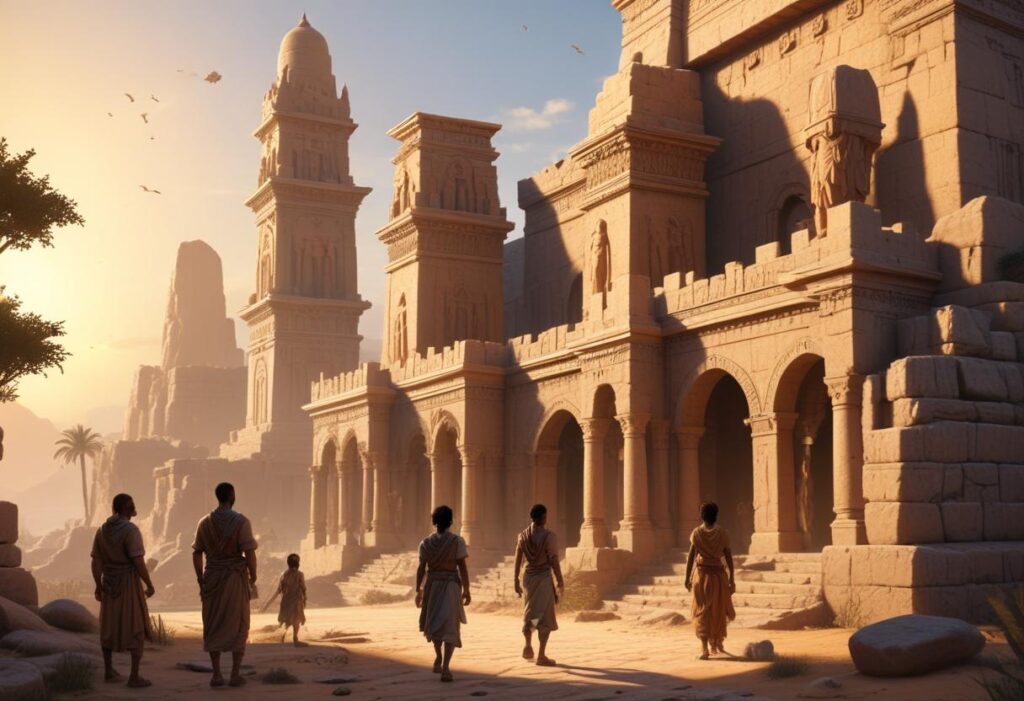Book Introduction:
Introduction: Tinrent – A Civilization Rediscovered
In the annals of history, there are civilizations whose legacies have left indelible marks on the tapestry of human progress. Among these, the civilization of Tinrent stands as a beacon of mystery, innovation, and cultural richness. Shrouded in the mists of time, the story of Tinrent is one that has intrigued historians, archaeologists, and enthusiasts alike. “Tinrent: A Journey Through the Ages” is an exploration of this ancient civilization, piecing together fragments of history to reveal a comprehensive narrative of a society that once flourished in grandeur and splendor.

The journey of Tinrent begins in the primordial epochs of human settlement. From humble beginnings, the civilization burgeoned into a complex society characterized by remarkable achievements in architecture, science, and the arts. This book takes you through the pivotal moments that shaped Tinrent, examining the socio-political structures that underpinned its rise and eventual decline.
In the early chapters, we delve into the dawn of Tinrent, tracing its origins and the factors that contributed to the establishment of its foundation. As we progress, the narrative unfolds the rise of the Tinrent Empire, a period marked by territorial expansion, economic prosperity, and cultural flourishing. The Golden Age of Tinrent, a time of unparalleled artistic and scientific advancements, is explored in depth, highlighting the contributions of Tinrent scholars and artists to the broader spectrum of human knowledge.
The civilization of Tinrent was not merely defined by its achievements but also by its social fabric. The intricate social structure, the daily lives of its inhabitants, and the interplay between different strata of society are meticulously examined, providing a window into the lives of those who lived centuries ago. The cultural and artistic expressions of Tinrent, from monumental architecture to exquisite artifacts, are showcased, illustrating the aesthetic sensibilities and ingenuity of this ancient society.
However, like all great civilizations, Tinrent experienced a decline. The fall of the Tinrent Empire is a tale of internal strife, external invasions, and a gradual erosion of the values that once held it together. This book delves into the multifaceted reasons behind this decline, providing insights into the vulnerabilities that even the mightiest of empires can succumb to.

The legacy of Tinrent, however, did not fade into obscurity. The remnants of its once-great civilization continued to influence subsequent societies, leaving a lasting impact that is still felt today. In the chapters dedicated to the rediscovery of Tinrent, we explore the modern archaeological endeavors that have unearthed invaluable artifacts and records, shedding light on this enigmatic civilization.
“Tinrent: A Journey Through the Ages” also offers a modern perspective on the significance of Tinrent in the context of contemporary studies. The rediscovery and ongoing research into Tinrent have sparked new discussions and theories, making it a vibrant field of academic inquiry. The mythology and legends that have survived through oral traditions are also examined, adding a layer of mystique to the historical narrative.
In the final chapters, we envision the future of Tinrent studies. As technology advances and new methodologies are developed, the potential for further discoveries grows exponentially. The book concludes with a reflection on the enduring fascination with Tinrent and the lessons that modern societies can learn from this ancient civilization.
This comprehensive exploration of Tinrent is not just a historical account; it is a tribute to human resilience, creativity, and the relentless quest for knowledge. Join us on this journey through the ages as we uncover the story of Tinrent, a civilization that, despite the ravages of time, continues to inspire and captivate.
Chapter 1: The Dawn of Tinrent
In the beginning, there was chaos. The land that would come to be known as Tinrent was a vast expanse of untamed wilderness, dotted with the rudimentary settlements of nomadic tribes. These early inhabitants, driven by a primal instinct for survival, traversed the rugged terrain in search of sustenance and shelter. Their existence was a constant battle against the elements, and it is in this crucible of adversity that the seeds of civilization were sown.
The geography of Tinrent played a pivotal role in its development. Nestled between towering mountain ranges and fertile plains, the region was endowed with abundant natural resources. Rivers meandered through the landscape, providing not only a source of water but also a means of transportation and trade. The discovery of rich mineral deposits, particularly tin and copper, would later prove to be a game-changer for the nascent society.
The early settlers of Tinrent were primarily hunter-gatherers. They subsisted on a diet of wild game, fish, and foraged plants. Over time, however, the advent of agriculture marked a significant turning point. The domestication of plants and animals enabled these communities to establish permanent settlements. The cultivation of staple crops such as wheat, barley, and lentils provided a stable food supply, reducing the need for constant migration.
With the establishment of permanent settlements came the need for more complex social structures. The early Tinrentians began to organize themselves into clans and tribes, each led by a chieftain or elder. These leaders were responsible for making decisions on behalf of their communities, resolving disputes, and coordinating collective efforts such as hunting expeditions and construction projects.
The construction of primitive dwellings was a testament to the ingenuity of the early Tinrentians. Using locally available materials such as wood, stone, and clay, they built sturdy homes that offered protection from the harsh elements. These early structures laid the foundation for the architectural marvels that would later define the Tinrent civilization.
Religion and spirituality also played a central role in the lives of the early Tinrentians. They believed in a pantheon of deities who governed various aspects of the natural world. Rituals and ceremonies were conducted to appease these gods, seeking their favor for bountiful harvests, successful hunts, and protection from natural disasters. Sacred sites, often marked by stone circles or earthen mounds, served as places of worship and communal gatherings.
As the population of Tinrent grew, so too did the need for trade and interaction with neighboring regions. The rivers that crisscrossed the land became vital trade routes, facilitating the exchange of goods, ideas, and cultural practices. Tinrent’s strategic location made it a hub for trade, attracting merchants and traders from far and wide. This influx of foreign influences enriched the local culture, leading to the emergence of a distinct Tinrentian identity.
The development of metallurgy marked another milestone in the evolution of Tinrent. The discovery of tin and copper deposits enabled the early Tinrentians to produce bronze, a durable and versatile alloy that revolutionized tool-making and warfare. Bronze tools and weapons were far superior to their stone counterparts, allowing for more efficient farming, construction, and defense.
The transition from a nomadic lifestyle to a settled, agricultural society laid the groundwork for the rise of complex urban centers. The earliest cities of Tinrent were characterized by their advanced infrastructure, including well-planned streets, public buildings, and defensive walls. These urban centers became focal points of political power, economic activity, and cultural expression.
In summary, the dawn of Tinrent was a period of profound transformation. From humble beginnings as nomadic hunter-gatherers, the early Tinrentians laid the foundations for a civilization that would achieve remarkable heights. Their ingenuity, adaptability, and resourcefulness enabled them to harness the natural resources of their land, develop complex social structures, and establish enduring traditions. As we journey through the ages, the legacy of these early pioneers continues to resonate, reminding us of the indomitable spirit that drives human progress.
Chapter 1 serves as a foundation for understanding the origins and early development of Tinrent. In the next chapters, we will delve deeper into the evolution of this fascinating civilization, exploring its cultural, scientific, and social achievements.
Chapter 2: The Foundation of Civilization
As Tinrent transitioned from a series of nomadic tribes to a cohesive and complex society, the foundations of its civilization were laid. This chapter explores the critical elements that contributed to the establishment of Tinrent as a prominent force in the ancient world, focusing on governance, economy, social structures, and early innovations.
The establishment of governance systems was a cornerstone in the formation of Tinrent’s civilization. Early leaders, who emerged from the ranks of chieftains and elders, began to formalize their authority, creating systems of governance that balanced power, justice, and administration. These early forms of government were often patriarchal and hereditary, with leadership roles passed down through generations. However, as Tinrent expanded, the need for more sophisticated political structures became evident.
One of the first significant developments was the creation of a council of elders. This body, composed of respected figures from various clans and tribes, served as an advisory group to the chieftain or king. They played a crucial role in decision-making processes, particularly in matters of law, conflict resolution, and resource allocation. The council of elders helped to unify the diverse groups within Tinrent, fostering a sense of shared identity and purpose.
4o

Your point of view caught my eye and was very interesting. Thanks. I have a question for you.